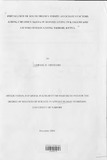Prevalence of malnutrition and its associated factors among children aged 6-59 months living in Kangemi and Gichagj Sub locations. Nairobi, Kenya.
Abstract
Malnutrition, which is a wide spread problem with devastating consequences, weakens
immune system and worsens illness. It is a factor in about half of the deaths that occur
among children under five years of age. Malnourished children who survive are more
likely to have diminished learning capacity and lower productivity in adulthood. Children
who are under five years of age are at higher risk of suffering from malnutrition than other
sector of the population. In many of the underdeveloped countries, two thirds of all deaths
occur among children under the age of five.
A cross-sectional survey that aimed at assessing nutritional status of children aged (6-59
months) and at identifying the associated household risk factors was conducted in
Kangemi Location in Nairobi Kenya, between March and April 2003.
The main objective of the study was to determine the nutritional status and establish its
associated factors in order to identify the risk factor for children aged 6-59 months old in
Kangemi Location, Nairobi, Kenya.
Multistage Sampling was used to identify study households and four villages out of seven
villages were selected randomly. A sample size of 330 households in which there had to be
a child aged between 6-59 months was used. In households with more than one child in
this age category, only one child (the younger one) was picked as the index child using
purposive sampling.
A sub-sample of 66 households was randomly selected for the 24-hour dietary recall. The
data was collected with the assistance of five field assistants. A structured questionnaire
was used to collect quantitative data on sociodemographic and economic characteristics,
food intake of the study children and anthropometric measurement (height and weight)
were collected and used for generating indices of nutrition status. Data entry, cleaning and
analysis was done using the statistical package for Social Sciences (SPSS version 10.0)
and indices of nutritional status were computed using the EPI-Info (version 6.0) packages.
The study established that the prevalence of malnutrition in the study area was as follows;
global acute malnutrition (wasting), 4.9%, global chronic malnutrition (stunting) 27.1%
and global underweight (12.1%). This is in reference to World Health Organization,
(WHO) that is <-3 Z-score for severe malnutrition and <-2 Z-score for global malnutrition.
The analysis showed that moderate chronic malnutrition increases with age, especially
after 24 months of age suggesting that when children stop breastfeeding their nutritional
status is affected probably because of inadequate supplementary feeding.
All two thirds (60%) of the study children were reported to have been ill within the last
seven days preceding the survey. Symptoms of upper respiratory tract infections were the
most commonly reported condition. Level of household income, illness, amount of water
used in a household and sex of household head were found to be associated factors with _
nutritional status of children under five. Socioeconomic' status and education level of.
In conclusion, SInce it has been proved that level of household income influences the
consumption frequency as well as the amounts consumed by children under five years of
age, putting in place income generating activities in the community to increase the
purchasing power of the head of households would improve the food intake of the children.
Improvement of water system, health facilities, and waste disposal is recommended since
they contribute to poor health.
The result of this study can be used to develop intervention
Citation
Gobane, D. C(2004). Prevalence of malnutrition and its associated factors among children aged 6-59 months living in Kangemi and Gichagj Sub locations. Nairobi, Kenya.Sponsorhip
University of NairobiPublisher
Department of Food Science, Nutrition and Technology, University of Nairobi
Description
Msc- Thesis

